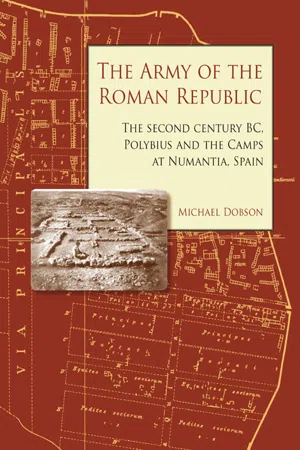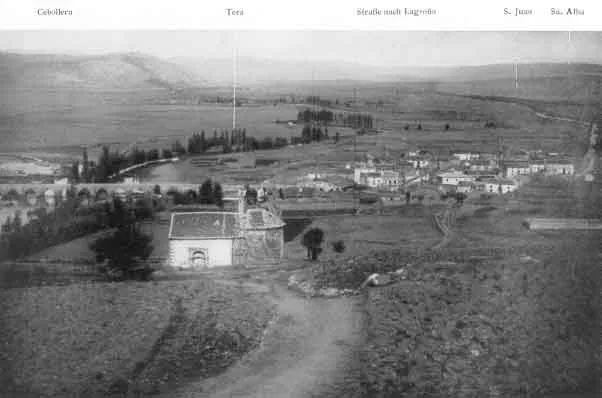![]()
1 The archaeological and literary evidence relating to Numantia
The history of the identification of Numantia
The destruction of Numantia by the Romans was a popular story in Spain during the medieval period; it had the appeal of the heroic local people resisting the invader.
The exact location of the city was uncertain. From the thirteenth century a commonly held location was Zamora, as Orosius and Florus suggested that Numantia lay on the river Duero, and this was the largest town on the river at that time (Schulten 1931, 5; fig. 5).
When the text of Appian’s Spanish Wars became known in 1557, the idea of Numantia being on the Duero seemed to be confirmed, as Appian referred to the city being on the river ∆óρıον (Spanish Wars 91; Blech 1995, 39; Schulten 1931, 5 ff.).
Doubts about Zamora being the location of Numantia began during the fifteenth century and opinion started to favour the area of Soria (Schulten 1931, 6; fig. 5).
In 1575 the antiquarian Ambrosio de Morales proposed that Numantia lay a little to the north of Soria on a hill – La Muela – just to the south of Garray (de Morales 1575, 105; Blech 1995, 39, n. 8; figs 7 and 9). This suggestion followed careful study of features mentioned in Appian’s account of the siege, and of the itineraria of the road from Augustobriga to Uxama (modern Muro de Ágreda to Osma; fig. 5), since a number of classical sources stated that Numantia lay where this road crossed the Duero (Schulten 1931, 17 with n. 3; 1933b, 156).
Supportive of this interpretation was the location of the hill relative to the Duero, and on the hill were visible remains of an ancient settlement, in the middle of which was a lone medieval chapel containing a Roman tombstone (Schulten 1931, 9; 1933b, 156; fig. 8).
This location for Numantia was popularised by a tragedy entitled Numancia written by Miguel de Cervantes in c.1581 and by numerous poems which followed this (Schulten 1931, 6 ff.). All of these extolled the virtues of the native Iberians valiantly fighting against the foreign invader.
During the eighteenth century there was renewed interest in the question of Numantia, and antiquarian activity centred its work on La Muela hill by Garray (Schulten 1933b, 156). This greatly strengthened the idea that the site of Numantia was here, with, for example, remains of city walls being observed.
The first major publication of these findings, with the earliest published plan of the site, was by Juan Loperraez in 1788 (Schulten 1931, 10; 1933b, 157).
The first excavations took place in 1803, by a Basque literary figure and senior royal financial official, Juan Bautista Erro y Aspiroz, and the Asociación económica de los amigos del país of Soria. Nothing of these excavations was published other than a Celtiberian inscription (Blech 1995, 40; Erro 1806).
In 1853 Edoardo Saavedra, a respected Spanish antiquarian and an engineer, carried out a programme of road-building in the area of Garray. This led him to research the Roman roads of the area, in particular to try to establish the course of the Augustobriga-Uxama road. As part of this, he surveyed La Muela hill and excavated on it (Schulten 1933b, 157).
Fig. 7 Numantia from the south, from El Cañal hill just west of La Rasa (Schulten 1931, Abb. 5; see fig. 9). La Muela hill (Numantia) is near the middle of the photograph. Garray can be seen beyond the left side of the hill The river Duero curves round the bottom left and near sides of the hill, on to the bottom left-hand corner of the photograph. The camp at Molino lies just this side of the wooded area on the middle right-hand side of the photograph. Dehesilla hill is on the middle lefthand side.
Saavedra also carried out work on La Gran Atalaya hill by Renieblas, to the east of Garray, since this area seemed to him to be a better location for Numantia and hence the line of the Augustobriga-Uxama road (Schulten 1931, 17; figs 6 and 12). Saavedra found remains of walls here, but concluded that they were animal pens (Schulten 1931, 17): Schulten’s work was later to reveal that these same walls were in fact part of a whole complex of Roman camps contemporary with the Numantine Wars. In 1861, Saavedra presented his findings to the Real Academia de Historia; they were not published until 18 years later (Blech 1995, 40, n. 13; Saavedra 1879).
Thanks to the fieldwork and efforts of Saavedra, in 1861 the Academia established the Comision de Monumentos in Soria, to further excavate La Muela hill. These excavations began in 1861 and continued until 1867. Only the 1861 season was ever published (Delgado et al. 1877), the other seasons having merely a summary report, produced for the Academia in 1867 and signed by Fernandez Guerra and Saavedra (Blech 1995, 40 f.; Schulten 1931, 17).
These poor quality excavations found the remains of a Roman city, but concluded that nothing of an earlier Iberian one was to be seen (Schulten 1931, 18; 1933b, 157). This had the negative effect of reducing interest in the site and even meant that farmers were allowed to rob the site for stone, despite the hill being declared a state-protected national monument in 1883 (Schulten 1933b, 157).
Fig. 8 View to the north of La Muela, up the plain of the river Tera, over Garray to the hills beyond (Schulten 1931, Abb. 2). The river Duero can be seen on the middle left-hand side of the photograph, being crossed by the road bridge from Soria. The medieval chapel containing the Roman tombstone is in the foreground.
As a result, at the beginning of the twentieth century it was still in question whether La Muela hill was the site of the Iberian city that resisted the Romans so famously. Schulten set out to prove it (Schulten 1933b, 157).
The archaeological evidence from Numantia – the work of Schulten
The chronology and extent of the excavations
Schulten relates, more than once, rather ‘romantically’ how his interest in Numantia began. He says that it started one night in Göttingen during the winter of 1901–2, when he was reading Appian’s description of Scipio’s siege of Numantia (Blech 1995, 41; Schulten 1914, vii). A few months later, in 1902, he visited La Muela hill for the first time. He was readily convinced it was the location of Numantia, as its topography matched so closely what he had read in Appian. He resolved to carry out a programme of research and excavation there to demonstrate that this was indeed the location of Numantia (Schulten 1933b, 157).
Between 1902 and 1905 Schulten worked on all the relevant available material (Schulten 1914, vii). This led to his first publication on Numantia, in 1905, in which he described all previous work on the subject and the topography of the locality of the hill by Garray (Schulten 1905a).
From this preliminary work, Schulten drew up a list of aims for a programme of fieldwork and excavation. Of prime importance was to excavate further in the city and show that the Iberian city of Numantia lay under the Roman one already known about. Secondly, the Roman siegeworks described by Appian were to be located and investigated. Schulten also wanted to locate the Numantine cemetery, so that he could learn more about Iberian culture (Schulten 1931, 12). From this he hoped to advance knowledge in three specific areas: the Roman art of war, Iberian antiquities, and the siege and defeat of Numantia (Schulten 1931, 13).
It was intended that the work would be completed by 20 workers in 20 days (Schulten 1931, 14). In reality, Schulten carried out substantial excavations annually between 1905 and 1912, with a team of generally 20 to 30 excavators, but several times with as many as 60, digging up to 11 hours a day, and he spent a total of 22 months in the field (Schulten 1931, 33 n. 5; 36). There was also a very minor season in 1927; Schulten refers to this as a small ‘postscript’ excavation (kleine Nachtrag-Grabung – 1929, 143; below p. 21).
Schulten obtained permission to excavate through the efforts of Saavedra, who was chair of the Comision de Monumentos in Soria (Blech 1995, 42 f.). The Spanish authorities ignored a loud protest from some of the local press against foreign excavations on such a nationally important site, but such protest was a hint of what was to come (Schulten 1931, 20; below, p. 16). Funding came from the Göttingen Gesellschaft der Wissenschaften and the Berlin Akademie der Wissenschaften (Blech 1995, 42 ff.; Luik 2002, ix; Schulten 1905b, 162; below, p. 21).
Excavations began during the afternoon of 12th August 1905 on La Muela hill under the supervision of Schulten and Koenen (Blech 1995, 43; Schulten 1905b; 1931, 16; 1933b, 157). By early evening the burnt remains of the expected Iberian city were discovered under the Roman city – “The city destroyed by Scipio in 133 BC, the famous Numantia, was found!” (Die im Jahre 133 v. Chr. von Scipio zerstörte Stadt, das berümte Numantia, war gefunden! – Schulten 1931, 17). The excavations continued until 10th November when snow and cold prevented their continuation that year (Schulten 1905b, 166; 1931, 19). They recovered a large quantity of Iberian material, revealed many buildings, sections of the defences and street layout. Evidence for a Roman siege was recovered in the form of ballista balls and slingstones (Schulten 1931, 20).
Fig. 9 The area around Numantia showing the Roman military features, surveyed by Lammerer and published by Schulten (reduced from Schulten 1927b, Plan I; original in...



